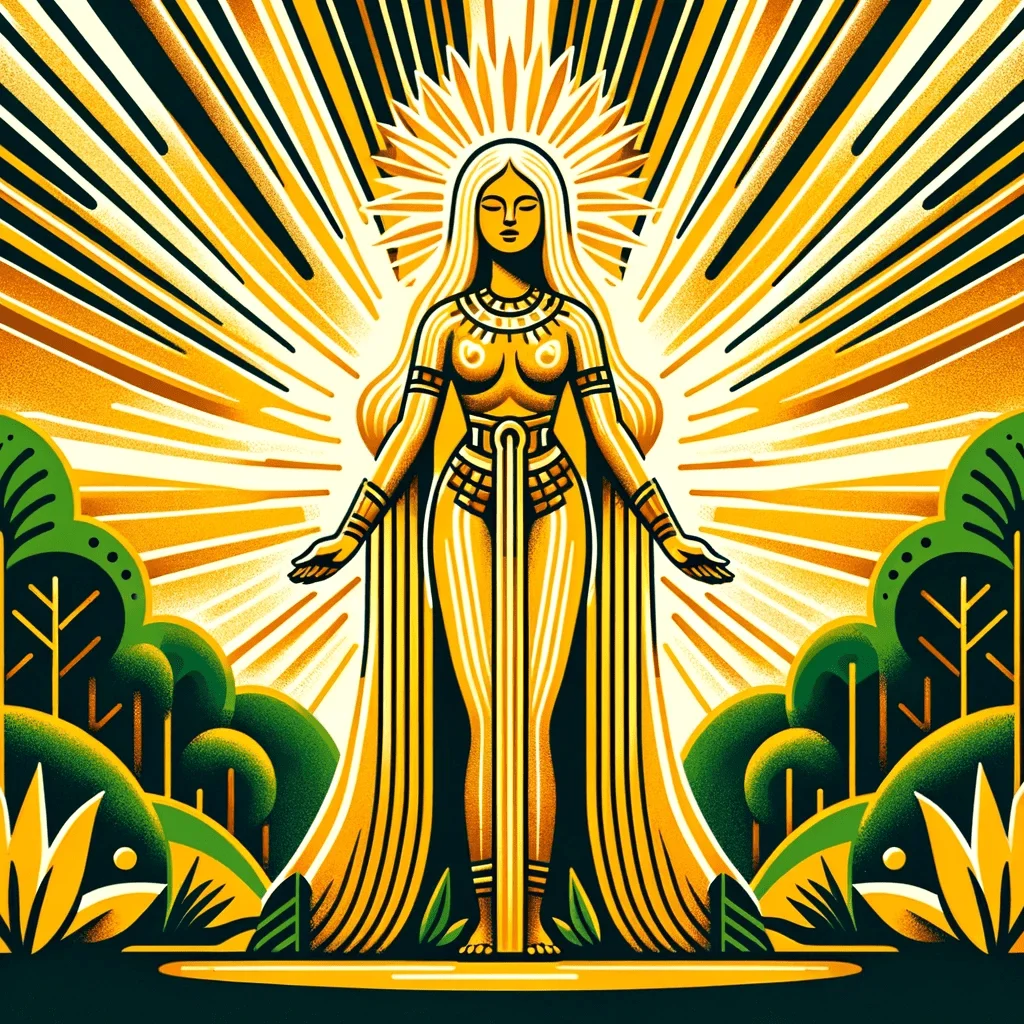The Golden Woman – Guatemalan Mayan Mythology

The Golden Woman is a figure from Guatemalan Mayan mythology who is said to have blonde hair and is associated with the sun and with wealth. According to legend, the Golden Woman is a powerful goddess who provides abundance and prosperity to those who honor her, and is often venerated through offerings and rituals.
According to Guatemalan Mayan mythology, the Golden Woman is a goddess who is associated with the sun, with fertility, and with wealth. She is said to have blonde hair and is often depicted wearing a golden headdress or other regal clothing. The Golden Woman is believed to have the power to provide for her followers and to bring prosperity and abundance to those who honor her through offerings and rituals.
Despite this, many people continue to view the sun as a divine entity, and some have even attempted to link the behavior of the sun to various mythological figures. For example, some New Age and spiritualist sources have claimed that the sun’s activity is influenced by the alignment of planets or the consciousness of human beings, although these claims are not supported by any credible scientific evidence.
Golden Woman:
- According to Mayan legend, the Golden Woman is said to have the power to bring wealth and prosperity to those who honor her through offerings and rituals, and is often venerated through elaborate ceremonies and sacrifices. (Source: Ancient Origins)
- The Golden Woman is often associated with the sun and with fertility, and is sometimes depicted wearing a headdress or clothing made of gold or other precious materials. (Source: World History Encyclopedia)
- The worship of the Golden Woman continues to be an important part of Mayan culture in Guatemala, where she is seen as a symbol of wealth and abundance. (Source: National Geographic)
- While there is no scientific evidence to support the idea that the Golden Woman is a real entity or that she has any direct impact on the natural world, her importance as a cultural and spiritual figure in Mayan mythology is widely recognized by scholars and experts in the field of anthropology and religious studies.
- In popular culture, the Golden Woman and other mythological figures continue to be the subject of books, movies, and other media. While these stories may be entertaining or informative, it is important to remember that they are fictional and do not necessarily reflect the beliefs or practices of any particular culture or religion.
- When evaluating claims about mythological figures like the Golden Woman, it is important to consider the credibility and reliability of the sources being used. While reputable sources like scholarly journals, encyclopedias, and established news outlets can provide valuable information and context, uncreditable sources like conspiracy theories or pseudoscientific beliefs are often not backed up by credible evidence and should be viewed with skepticism.
Guatemalan Mayan mythology is a rich and complex system of beliefs, stories, and practices that have been passed down through the Mayan culture for thousands of years. The Mayan civilization was one of the most advanced in the Americas prior to the arrival of the Spanish in the 16th century, and their mythology reflects a deep reverence for the natural world, as well as a complex system of deities, spirits, and other supernatural entities.
Central to Mayan mythology is the belief in a number of powerful deities, who were associated with different aspects of the natural world, such as the sun, the moon, the stars, and the earth. These deities were often venerated through complex rituals, which included offerings, sacrifices, and other symbolic acts.
One of the most important themes in Guatemalan Mayan mythology is the idea of the cyclical nature of time, which is reflected in the complex calendrical systems developed by the Mayans. The Mayan calendar was a sophisticated system that tracked the movements of the sun, the moon, and the planets, and was used to mark important cultural events, as well as to predict astronomical phenomena.
Another important aspect of Mayan mythology is the belief in a number of supernatural entities, such as spirits and demons, who were thought to inhabit the natural world and could be both benevolent or malevolent. These entities were often venerated through a variety of rituals and offerings, and were believed to have the power to influence the natural world in significant ways.
While the Spanish conquest of the Americas in the 16th century had a significant impact on Mayan culture and religion, many aspects of Guatemalan Mayan mythology continue to be practiced and celebrated by modern-day Mayan communities. These practices reflect a deep reverence for the natural world, as well as a complex and multifaceted system of beliefs and practices that has evolved over thousands of years.


